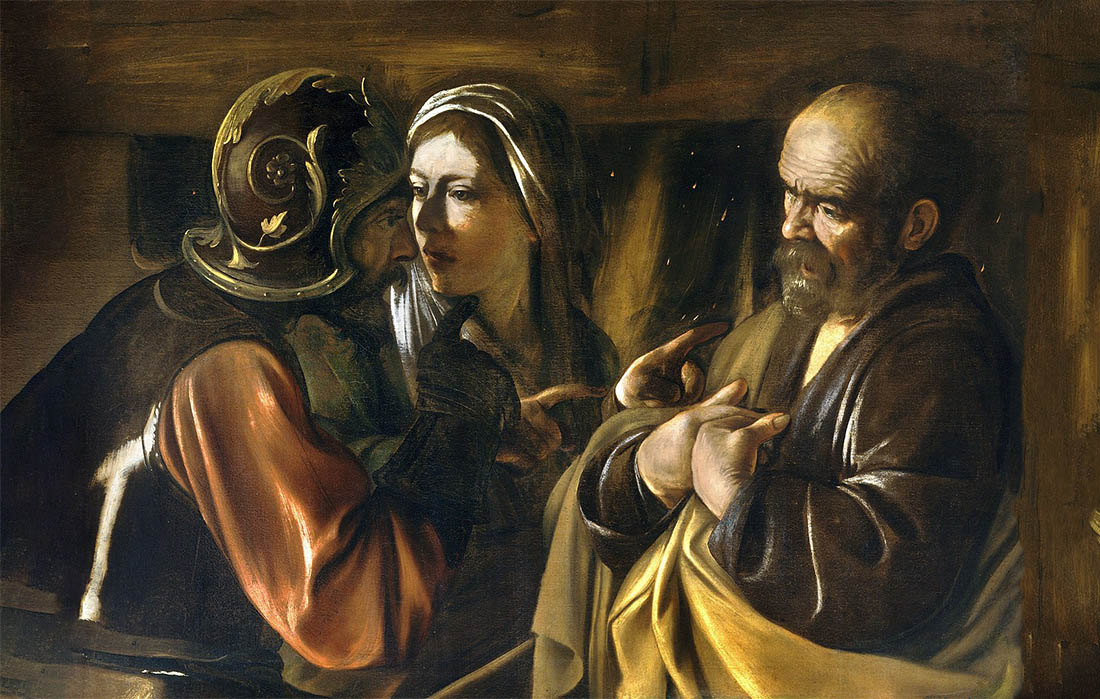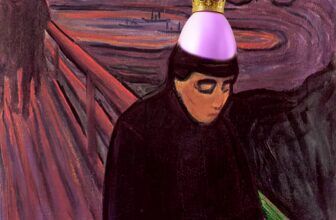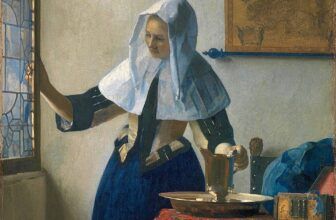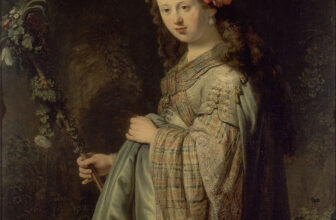
The Denial of Saint Peter: Meaning, Symbolism, and Controversy
Few paintings in the history of art manage to compress drama, human weakness, and spiritual depth into a single frame as Caravaggio’s The Denial of Saint Peter (1610). This late work by the Italian master remains both haunting and enigmatic, embodying not just the biblical story it illustrates, but also the turbulent final years of Caravaggio’s own life. Today, the painting is celebrated as one of his most psychologically penetrating pieces, but it has also been the subject of heated debate, mystery, and even controversy. To understand it fully, one must consider not only its narrative but also its style, context, and enduring symbolism.
What The Denial of Saint Peter is About
The painting depicts one of the most dramatic and painful moments in the New Testament, the Apostle Peter’s denial of Jesus Christ. According to the Gospels, on the night of Jesus’ arrest, Peter followed at a distance as Christ was taken to the high priest’s house. While warming himself near a fire in the courtyard, Peter was confronted by bystanders who accused him of being a follower of Jesus. Terrified, Peter denied knowing him, not once, but three times, just as Christ had foretold. Immediately after the third denial, a rooster crowed, and Peter realized his betrayal, weeping bitterly in shame and repentance.
Caravaggio’s painting captures the pivotal instant of confrontation. A soldier points accusingly at Peter, while a maidservant echoes the charge with a raised hand. Peter, caught between fear and truth, clutches his chest as if to defend or shield himself. The tension is palpable: this is the precise moment of moral failure, the crossroads of courage and cowardice.
How and When Caravaggio Painted The Denial of Saint Peter
Caravaggio painted The Denial of Saint Peter around 1610, during the final and most desperate phase of his life. At the time, he was a fugitive. Four years earlier, in 1606, he had killed a man named Ranuccio Tomassoni in a duel in Rome and fled the city under threat of execution. In the years that followed, Caravaggio moved restlessly between Naples, Malta, and Sicily, painting feverishly while trying to secure a papal pardon. His late works, including The Denial of Saint Peter, are infused with a darker palette and a heightened sense of psychological introspection, mirroring his troubled existence.
The painting was commissioned, most likely, in Naples, where Caravaggio had returned after a violent episode in Malta. By then, his fame was immense, and wealthy patrons sought his art despite (or perhaps because of) his notoriety. Unlike many of his earlier grand commissions for chapels and altarpieces, this work was likely intended for private devotion or collection.
Stylistically, the painting bears all the hallmarks of Caravaggio’s late style: stark chiaroscuro (the dramatic contrast of light and dark), restrained color, and a focus on expressive realism rather than ornate detail. Gone are the elaborate settings or decorative backgrounds of earlier Renaissance art. Instead, Caravaggio thrusts the viewer into the raw, immediate encounter of accusation and denial.
What is Happening in The Denial of Saint Peter Painting
At first glance, the composition is deceptively simple: three figures locked in an exchange. Yet each element heightens the drama.
Peter sits in the foreground, gray-haired, rugged, his hand placed defensively on his chest. His face is turned away slightly, caught between shame and protest. His wide eyes convey fear, but also the dawning awareness of his weakness.
The Maidservant, positioned at the center, is the one who identifies Peter as a disciple. Her raised hand points toward him in a gesture of both recognition and accusation. She embodies the unrelenting voice of truth that Peter cannot escape.
The Soldier, standing to the left, points an accusatory finger directly at Peter. His armor and stern expression symbolize authority, law, and worldly judgment.
The figures are tightly grouped, almost claustrophobic, pushing the drama forward with no distractions. The setting is bare, the background swallowed in shadow. The focus is entirely on the psychological exchange, on human frailty exposed under the harsh spotlight of divine prophecy.
Symbolism and Meaning of The Denial of Saint Peter
Caravaggio was a master of layering symbolism into realistic scenes, and The Denial of Saint Peter is no exception. Several themes and symbols emerge:
The Rooster (Absent but Present)
Although the rooster itself is not depicted, its symbolic presence looms over the scene. The cockcrow serves as the divine marker of Peter’s betrayal, reminding viewers of Christ’s omniscience and the inevitability of human weakness.Hands as Symbols of Accusation and Defense
Each figure’s hand carries symbolic weight: the maidservant’s raised hand indicts, the soldier’s pointing finger condemns, and Peter’s clutching hand reveals his conflicted conscience, half defensive, half confessional.Light and Darkness
Caravaggio’s chiaroscuro here is not just a stylistic device but a moral metaphor. The faces and hands are illuminated, while the background is engulfed in darkness. Light represents truth, exposure, and divine prophecy, while darkness suggests fear, denial, and the hidden recesses of the human soul.Peter as Everyman
More than a portrait of a biblical apostle, Peter becomes a mirror for all humanity. His weakness and denial are universal human experiences, moments when fear triumphs over loyalty, when self-preservation eclipses conviction. Caravaggio transforms a sacred narrative into an intimate psychological study.
Why The Denial of Saint Peter Painting is Controversial
Several factors have fueled controversy and debate around this painting:
Attribution Questions
For many years, scholars debated whether The Denial of Saint Peter was truly by Caravaggio. The painting’s late style, marked by rough brushwork and an almost sketch-like quality, led some to doubt its authorship. Today, however, the majority of experts accept it as an authentic work from his final year.Stylistic Unfinished Quality
Some critics argue that the painting looks unfinished, its rough execution a sign of Caravaggio’s declining state. Others counter that this rawness is deliberate, reflecting the urgency and intensity of the moment.Psychological vs. Religious Focus
Unlike earlier depictions of the denial, which often emphasized theological symbolism, Caravaggio zeroes in on the psychological drama. For some viewers in the 17th century, this stark realism was unsettling, too human, too stripped of sanctity.Biographical Resonance
Caravaggio’s own life of violence, exile, and desperation inevitably colors interpretation. Many have seen Peter’s fear and guilt as a reflection of the artist’s own tormented conscience. Was Caravaggio, like Peter, aware of his betrayal and longing for redemption? The blurred line between art and autobiography has fueled endless speculation.
The Type of Art: Baroque Drama in Its Purest Form
The Denial of Saint Peter belongs to the Baroque period, a style characterized by emotional intensity, theatrical realism, and dramatic use of light. Caravaggio was one of the great pioneers of Baroque art, and this painting exemplifies the movement’s core principles:
Realism: The figures are not idealized saints but ordinary people, depicted with gritty naturalism.
Emotion: The scene brims with psychological tension rather than decorative beauty.
Chiaroscuro: The stark contrast of light and shadow dramatizes the confrontation, pulling the viewer directly into the scene.
Unlike Renaissance art, which often sought balance and harmony, Baroque art embraced tension, immediacy, and the rawness of experience. Caravaggio’s painting is a quintessential example of this ethos.
The The Denial of Saint Peter Painting’s Location
Today, The Denial of Saint Peter is housed in the Metropolitan Museum of Art in New York City. It entered the museum’s collection in the 20th century and has since become one of its most studied and admired works of Baroque art. Visitors often find themselves drawn to its quiet yet explosive drama, standing spellbound before the interplay of faces and hands, light and shadow.
What is The Denial of Saint Peter Painting Represents
At its core, The Denial of Saint Peter is a meditation on human weakness, guilt, and the possibility of redemption. It is not the triumphant moment of faith but the fragile instant of failure that Caravaggio chooses to depict. In doing so, he reveals the complexity of the human condition, our capacity to falter even in moments that define us.
Peter’s denial is not the end of his story. After weeping bitterly, he eventually becomes the rock of the Church, the first Pope, and a symbol of forgiveness. Caravaggio’s painting thus reminds viewers that weakness does not preclude redemption, that failure can become the ground for transformation.
For Caravaggio himself, who was nearing the end of his turbulent life, the painting may have held deeply personal resonance. Hunted, desperate for pardon, and burdened by guilt, he may have seen himself in Peter, caught in the painful recognition of weakness but still yearning for grace.
Caravaggio’s The Denial of Saint Peter is not simply a biblical illustration but a profound exploration of human frailty and divine truth. Painted in the shadow of the artist’s own impending death, it compresses an entire moral universe into the gestures of three figures. Its controversy lies in its rawness, its refusal to beautify or sanitize, its insistence on showing the sacred through the lens of human vulnerability.
Today, standing before the canvas in the Metropolitan Museum, one can still feel its power. The maidservant’s hand hovers, the soldier’s finger accuses, Peter’s eyes plead, and we, the viewers, are drawn into the drama, forced to confront our own denials and longings for redemption.
Caravaggio’s genius was not only to paint what happened, but to paint what it means. In The Denial of Saint Peter, he distilled the eternal struggle between fear and faith, weakness and grace, into an image that continues to speak across centuries.




